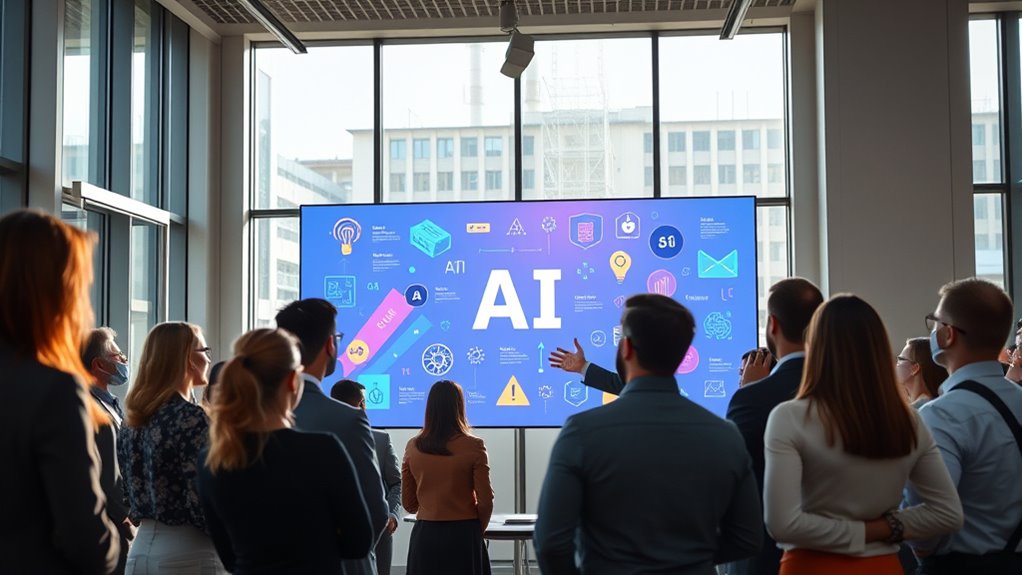Many businesses buy into AI myths that overestimate costs, complexity, and fears of job loss. In reality, AI tools are more accessible and affordable than you think, often requiring small investments and manageable changes. Human oversight is essential for ethical use and better decision-making. If you want to cut through the confusion and learn how to implement AI responsibly and effectively, there’s more to uncover right here.
Key Takeaways
- Many believe AI costs are prohibitive, but costs have decreased significantly, making implementation accessible for most businesses.
- The myth that AI can fully replace human judgment ignores the importance of oversight, ethics, and contextual understanding.
- AI is often seen as a universal solution, but targeted applications yield better results than trying to automate everything.
- Common misconceptions over AI’s originality and emotional nuance overlook its strengths in pattern recognition and data analysis.
- The perception that AI adoption is slow or limited is false; costs are declining and adoption is accelerating across business sizes.
Demystifying AI’s Role in Job Automation

While AI often gets a bad rap for taking away jobs, the reality is more nuanced. Yes, AI has eliminated some roles, like data entry clerks and routine customer service jobs, but it’s also creating new opportunities. In 2025 alone, over 76,000 jobs were lost, yet AI spurred significant job growth in emerging fields such as AI engineering and content creation. Many industries, including manufacturing and design, are transforming, requiring workers to develop AI fluency and new skills. The rapid pace of AI adoption, with 75% of knowledge workers using AI tools, has driven a shift toward more specialized and higher-skill roles. While roles involving predictable tasks are most vulnerable, AI also enhances productivity, allowing workers to focus on higher-value tasks. This ongoing transformation underscores the importance of upskilling and continuous learning, enabling the workforce to adapt to the evolving landscape. Overall, AI reshapes the job landscape—not just by replacing jobs but by opening pathways for innovation and new career paths.
Human Oversight: The Heart of Effective AI

You play a crucial role in ensuring AI systems are used ethically and responsibly. By balancing automation with your judgment, you help prevent biases and safeguard individual rights. Effective oversight keeps AI aligned with societal values and builds public trust. Rigorous oversight and safeguards are essential to address system limitations and prevent harm. Moreover, understanding the methodologies used in ethical hacking can provide valuable insights into identifying potential vulnerabilities within AI systems.
Ensuring Ethical AI Use
Ensuring ethical AI use hinges on effective human oversight, which serves as a critical safeguard against potential harms and biases. The EU Artificial Intelligence Act emphasizes the need for human involvement in high-risk systems, requiring appropriate interfaces for oversight and proportional measures based on risk levels. Regular audits, both internal and external, help evaluate technical performance and operator reliance, reducing automation bias. Timing outputs thoughtfully and designing user-friendly systems enable better human judgment and intervention. Training operators in critical thinking and fostering organizational support are essential for maintaining oversight quality. Continuous monitoring throughout the AI lifecycle ensures alignment with ethical standards, protects individual rights, and builds public trust. Engaging diverse stakeholders in oversight further enhances fairness and helps identify hidden biases, safeguarding your organization’s reputation. Implementing comprehensive oversight mechanisms and understanding the hours of beauty stores is vital for maintaining ethical standards and fostering trust in AI systems.
Balancing Automation and Judgment
Balancing automation and human judgment is indispensable for effective AI deployment because machines alone cannot capture the complexity and nuance of real-world decisions. Human oversight ensures that AI’s recommendations align with organizational values and societal norms. AI lacks the nuanced judgment needed for complex, high-stakes scenarios, making human intervention indispensable. However, operators often hesitate to override AI due to fear of repercussions if the system is later proven correct. Effective oversight requires technical expertise, ethical awareness, and the ability to assess data quality and model performance. Human judgment is essential for adapting to new contexts and identifying biases. Ultimately, AI should support decision-making, with humans providing the contextual understanding and ethical oversight necessary for responsible, fair, and accurate outcomes. Additionally, ongoing AI security measures are vital to prevent vulnerabilities such as jailbreaking and bias exploitation that could undermine trust and safety.
Accessibility of AI for Small and Medium Businesses

Access to AI technology is becoming increasingly widespread among small and medium businesses (SMBs), with about 75% having already invested in AI tools. Many of these businesses fully integrate AI into daily operations, boosting efficiency and customer service. Growing SMBs are nearly twice as likely to invest in AI compared to struggling ones, highlighting AI’s role in growth. However, a perception gap exists—only one in three non-users see AI as common in their industry. Key uses include marketing, sales, and data analysis, helping businesses personalize customer interactions and reduce costs. Despite its benefits, barriers like security concerns, limited resources, and skills shortages still hinder adoption. AI adoption rates among SMBs are rising rapidly, indicating a shift toward widespread acceptance and integration. Additionally, the development of AI detectors is crucial for maintaining trust and authenticity in AI-generated content. Overall, AI is becoming more accessible, transforming SMBs into more competitive and efficient entities.
Setting Realistic Expectations for AI Capabilities

While AI offers powerful tools for businesses, it’s important to set realistic expectations about what it can and can’t do. AI excels at recognizing patterns, but struggles with originality, emotional nuance, and cultural context. It can inspire ideas but can’t imbue creations with deep human meaning or empathy, making it unsuitable for roles requiring emotional intelligence. Many companies face challenges moving beyond pilot projects because success depends more on organizational change and talent than technical fixes. ROI remains modest for most, with only a small percentage seeing significant revenue or cost benefits. Generative AI adoption is rising, but its full value is yet to be realized across entire organizations. AI’s limitations in creativity and emotional intelligence highlight the need for human oversight. Understanding these limitations helps you avoid overestimating AI’s capabilities and set practical goals aligned with its strengths, especially considering the personality traits that influence how AI integrates into workplace dynamics.
Cost and Complexity: Debunking Common Myths

Many believe AI is prohibitively expensive and complex to implement, but the reality is more nuanced. Smaller projects, like recommendation engines or telemedicine tools, can cost as little as $20,000, making AI accessible for many businesses. By understanding the actual costs and streamlining implementation, you can better evaluate AI’s true affordability and potential for your organization. Model complexity accounts for 30-40% of total costs, highlighting that not all AI projects require massive investments. Additionally, somatic therapy techniques demonstrate how tailored approaches can optimize outcomes without excessive expenditure.
Affordability of AI Tools
The perception that AI tools require massive investments and complex setups is increasingly outdated, thanks to rapid advancements in technology and market innovations. Today, AI costs are shrinking sharply—model inference costs have fallen over 280-fold since late 2022, and hardware prices decline around 30% annually. Cloud-based services offer flexible, pay-as-you-go pricing, making AI accessible for small businesses and startups. Open-source models further reduce expenses by eliminating licensing fees, closing performance gaps with proprietary options. Additionally, many AI tools now feature user-friendly APIs and automated setups, simplifying integration without expert knowledge. With the proliferation of affordable, scalable solutions, AI’s cost barrier is lower than ever, enabling businesses of all sizes to harness AI’s potential without breaking the bank. The availability of vetted product reviews helps businesses choose cost-effective and reliable AI tools tailored to their needs.
Simplifying Implementation Processes
Implementing AI often seems formidable due to perceived high costs and complexity, but this is largely a myth. You can simplify the process by focusing on manageable steps:
- Align workflows—break down existing processes and identify where AI adds value without disrupting your structure.
- Establish clear governance—create frameworks that prevent silos and ensure consistent AI deployment.
- Redesign workflows gradually—adapt accountability and responsibilities step-by-step to ease progressions.
- Build AI centers of excellence—combine expertise with autonomy, fostering collaboration and learning.
These actions help demystify AI integration, making it more approachable. With strategic planning and incremental changes, you transform AI from a formidable challenge into a practical advantage, reducing costs and complexity along the way.
Ensuring Data Privacy and Security With AI

Ensuring data privacy and security with AI requires a proactive approach, as organizations must balance the benefits of AI-driven insights with the need to protect sensitive information. Given that 68% of consumers are concerned about online privacy, transparency is crucial for building trust. You should adopt privacy-enhancing techniques and implement robust security measures, which can reduce data breach costs by nearly 40%. Offering clear disclosures and giving customers control over their data—such as opt-in and opt-out options—also helps reassure users. Additionally, continuous monitoring and testing of AI systems for bias and vulnerabilities are essential. Staying compliant with evolving regulations and adopting advanced AI models that improve transparency will further safeguard your data and foster responsible AI use. Developing a self-understanding of potential biases in AI systems can help organizations identify blind spots and improve overall data integrity.
The Collaborative Model: Combining Human and Machine

You need to recognize that human oversight is essential for effective AI collaboration, ensuring machines support rather than replace judgment. Ethical governance guides responsible integration, preventing biases and misuse. Remember, AI should augment human skills, not substitute them, to maximize both efficiency and ethical standards. Additionally, implementing privacy policies helps build trust and maintains compliance with data protection regulations.
Human Oversight Essential
Human oversight plays a crucial role in maximizing the benefits of AI by combining machine efficiency with human judgment. You’re responsible for guiding AI systems to ensure they deliver accurate, relevant results. When you oversee AI, you help adapt these systems to changing environments and business goals. Imagine:
- Visualizing a team where humans double-check AI classifications, boosting accuracy from 81% to 90%.
- Leveraging your creativity alongside AI’s pattern recognition to solve complex problems faster.
- Using your intuition to adjust AI outputs, ensuring they align with shifting market conditions.
- Merging your decision-making skills with AI insights for smarter, data-driven choices.
This collaboration enhances decision quality, but your active involvement remains essential to avoid pitfalls and maximize AI’s potential.
Additionally, incorporating trustworthiness of Patchology insights can help guide AI-powered decisions in skincare-related contexts.
Ethical Governance Matters
Why does effective AI governance require more than just technical safeguards? Because addressing moral challenges demands a collaborative approach that includes diverse stakeholders—affected communities, ethicists, legal experts. Transparency is crucial; explainability tools help you build public trust by making AI decisions understandable. Inclusive governance frameworks ensure fairness by reflecting societal values and counteracting biases, especially for vulnerable groups. Predictive analytics can aid in identifying potential ethical issues before they arise. Accountability clarifies responsibility, involving leaders and legislators in ethical oversight. A collaborative model fosters shared responsibility among government, industry, academia, and civil society through mechanisms like regulatory sandboxes and open-source tools. This dynamic, iterative process adapts as technology evolves, allowing you to respond effectively to emerging risks. Integrating these elements ensures AI development aligns with societal norms, promoting responsible and trustworthy innovation.
Augmentation, Not Replacement
The true potential of AI lies in augmenting human capabilities rather than replacing them, fostering a collaborative environment where both work synergistically. Imagine:
- A team where AI handles routine data analysis, freeing you to focus on strategic decisions.
- Creative tasks enhanced by generative AI, helping craft content faster and more accurately.
- Workforce skills bridging gaps as AI provides real-time support and training.
- Seamless workflows integrating AI reasoning with human judgment, boosting productivity and accuracy.
- Understanding contrast ratio and its impact helps optimize visual outputs in collaborative projects.
This collaborative model amplifies strengths, creating a more innovative, efficient workplace. It’s not about substitution but synergy—where humans and AI complement each other, unlock economic value and transforming how you work. The future is about working smarter, together.
AI Use Cases: Focused, Not Universal Solutions

Although AI offers powerful capabilities across various industries, its applications are best viewed as targeted solutions rather than one-size-fits-all fixes. You don’t need AI everywhere—focus on areas that generate real value. For example, AI-powered chatbots improve customer service by automating routine questions, saving time and reducing costs. In logistics, AI predicts demand fluctuations, optimizing routes and inventory levels. Use predictive analytics to uncover trends that drive smarter decisions. Here’s a quick look:
| Use Case | Impact |
|---|---|
| Customer Service | Faster support, happier clients |
| Operations & Logistics | Lower costs, better efficiency |
| Data Analysis | Smarter, data-driven decisions |
Targeted AI, not universal, maximizes your business potential.
A new sentence with industry-specific solutions and the rest of the sentence.
The Speed of AI Adoption Across Business Sizes

AI adoption is accelerating rapidly worldwide, but the pace varies considerably depending on company size. Large companies, with over 250 employees, show signs of saturation, slowing down new AI projects. Meanwhile, small and medium-sized enterprises (SMEs) continue to ramp up their AI efforts, thanks to accessible tools and lower barriers. Startups and smaller firms are leading early adoption in emerging AI domains, fueling global growth. Additionally, the role of automation in business intelligence is enabling even smaller organizations to analyze data quickly and make informed decisions, further accelerating their AI integration. Imagine these scenarios:
- Large corporations refining existing AI systems, focusing on efficiency.
- SMEs experimenting with AI-powered customer service and marketing.
- Startups rapidly deploying generative AI to outpace competitors.
- Emerging markets catching up, driven by innovative, nimble smaller firms.
This uneven pace shapes the future landscape of AI integration across business sizes.
Ethical AI Practices and Risk Management

You are trained on data up to October 2023. As you deploy AI, ethical practices and risk management are critical. Only 40% of people trust companies to handle AI responsibly, highlighting the importance of transparency and fairness. Addressing bias and ensuring explainability build trust and uphold ethical standards. Ethical data collection, especially from scraped or aggregated sources, is essential to prevent misuse. Failing to prioritize responsible AI can lead to regulatory fines, reputational damage, and lost customer loyalty. Many companies struggle with scaling responsible AI and establishing governance mechanisms that align with their values. Embracing ethical AI not only mitigates risks but also strengthens market position, fosters societal trust, and supports long-term sustainability. Prioritizing ethics today guarantees you’re prepared for tomorrow’s challenges. Additionally, understanding the types of dog names can help in creating more personalized and meaningful AI interactions.
Frequently Asked Questions
How Quickly Can Small Businesses Realistically Implement AI Solutions?
You can realistically implement AI solutions in your small business within 3 to 9 months. Start by focusing on a specific pain point, like marketing or automation, and run a pilot project to test its effectiveness. Use expert guidance to speed up the process and avoid common pitfalls. Remember, gradual scaling after initial successes guarantees sustainable growth, making AI adoption both practical and achievable for your team.
What Are the Primary Cost Factors in AI Deployment for Mid-Market Firms?
Cost concerns could cripple your AI deployment if you overlook key factors. Software licensing, hardware infrastructure, and development work drive initial expenses. Ongoing costs like maintenance, talent, and data management keep the cash flowing. You’ll also face costs for compliance, security, and scaling. To succeed, prioritize planning, budget for surprises, and understand that extensive costs—both initial and ongoing—are essential for realizing AI’s true value.
How Do Organizations Establish Effective Human Oversight of AI Systems?
You establish effective human oversight of AI systems by clearly defining roles and responsibilities for key stakeholders, including leaders, legal, HR, and technical teams. You implement ongoing monitoring, testing, and real-time evaluation to catch errors or biases early. You empower humans to intervene when needed, especially during high-risk situations, and embed oversight into your strategic risk management. Regular documentation and collaboration ensure accountability, transparency, and continuous improvement of your AI oversight processes.
Can AI Replace Strategic Decision-Making Entirely?
AI can’t replace strategic decision-making entirely. While it boosts data analysis, speeds up processes, and provides valuable insights, it lacks human judgment, creativity, and contextual understanding. You need to combine AI’s strengths with your intuition and ethical considerations to make well-rounded decisions. Use AI to support, not substitute, your strategic reasoning—this partnership leads to better outcomes and sustained competitive advantage.
What Are Common Pitfalls When Integrating AI Into Existing Workflows?
You often face pitfalls like underestimating integration complexity and rushing implementation without proper planning. Fragmented data, incompatible systems, and inadequate infrastructure slow progress. Resistance from employees and fear of job loss hinder adoption, while poor change management causes project failures. Overpromising AI capabilities leads to dissatisfaction. Without thorough data governance, security concerns, and strategic focus, your AI initiatives struggle to scale, deliver value, and meet expectations effectively.
Conclusion
Don’t let myths hold you back. AI isn’t a magic fix or a threat—it’s a tool that, when used responsibly and with human oversight, can elevate your business. While some worry about complexity or costs, the truth is that accessible, ethical AI solutions are within your reach. Embrace a collaborative approach, set realistic expectations, and see how AI can complement your expertise without replacing it—transforming challenges into opportunities.









